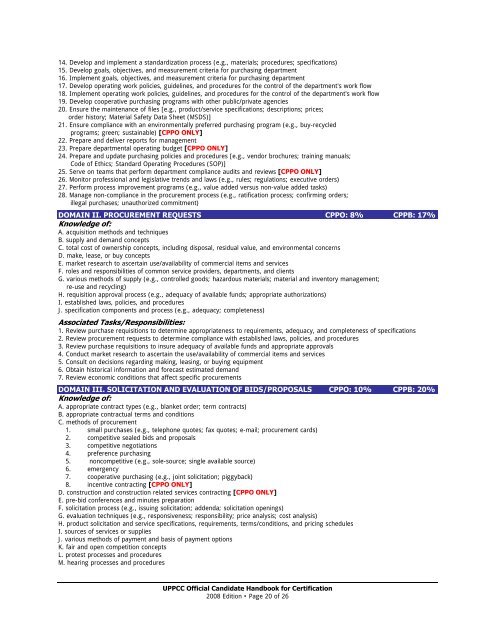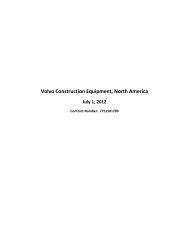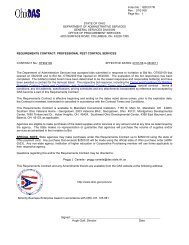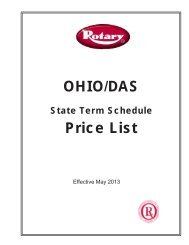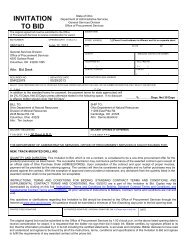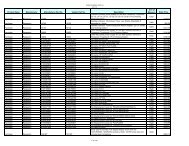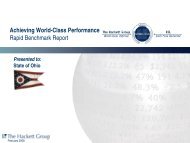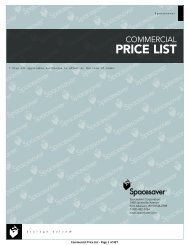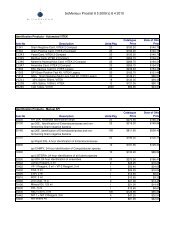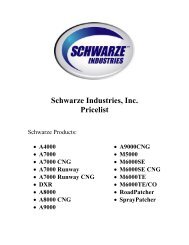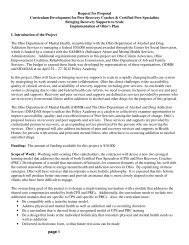Annual Opportunity Sizing - State Procurement - State of Ohio
Annual Opportunity Sizing - State Procurement - State of Ohio
Annual Opportunity Sizing - State Procurement - State of Ohio
You also want an ePaper? Increase the reach of your titles
YUMPU automatically turns print PDFs into web optimized ePapers that Google loves.
14. Develop and implement a standardization process (e.g., materials; procedures; specifications)<br />
15. Develop goals, objectives, and measurement criteria for purchasing department<br />
16. Implement goals, objectives, and measurement criteria for purchasing department<br />
17. Develop operating work policies, guidelines, and procedures for the control <strong>of</strong> the department's work flow<br />
18. Implement operating work policies, guidelines, and procedures for the control <strong>of</strong> the department's work flow<br />
19. Develop cooperative purchasing programs with other public/private agencies<br />
20. Ensure the maintenance <strong>of</strong> files [e.g., product/service specifications; descriptions; prices;<br />
order history; Material Safety Data Sheet (MSDS)]<br />
21. Ensure compliance with an environmentally preferred purchasing program (e.g., buy-recycled<br />
programs; green; sustainable) [CPPO ONLY]<br />
22. Prepare and deliver reports for management<br />
23. Prepare departmental operating budget [CPPO ONLY]<br />
24. Prepare and update purchasing policies and procedures [e.g., vendor brochures; training manuals;<br />
Code <strong>of</strong> Ethics; Standard Operating Procedures (SOP)]<br />
25. Serve on teams that perform department compliance audits and reviews [CPPO ONLY]<br />
26. Monitor pr<strong>of</strong>essional and legislative trends and laws (e.g., rules; regulations; executive orders)<br />
27. Perform process improvement programs (e.g., value added versus non-value added tasks)<br />
28. Manage non-compliance in the procurement process (e.g., ratification process; confirming orders;<br />
illegal purchases; unauthorized commitment)<br />
DOMAIN II. PROCUREMENT REQUESTS CPPO: 8% CPPB: 17%<br />
Knowledge <strong>of</strong>:<br />
A. acquisition methods and techniques<br />
B. supply and demand concepts<br />
C. total cost <strong>of</strong> ownership concepts, including disposal, residual value, and environmental concerns<br />
D. make, lease, or buy concepts<br />
E. market research to ascertain use/availability <strong>of</strong> commercial items and services<br />
F. roles and responsibilities <strong>of</strong> common service providers, departments, and clients<br />
G. various methods <strong>of</strong> supply (e.g., controlled goods; hazardous materials; material and inventory management;<br />
re-use and recycling)<br />
H. requisition approval process (e.g., adequacy <strong>of</strong> available funds; appropriate authorizations)<br />
I. established laws, policies, and procedures<br />
J. specification components and process (e.g., adequacy; completeness)<br />
Associated Tasks/Responsibilities:<br />
1. Review purchase requisitions to determine appropriateness to requirements, adequacy, and completeness <strong>of</strong> specifications<br />
2. Review procurement requests to determine compliance with established laws, policies, and procedures<br />
3. Review purchase requisitions to insure adequacy <strong>of</strong> available funds and appropriate approvals<br />
4. Conduct market research to ascertain the use/availability <strong>of</strong> commercial items and services<br />
5. Consult on decisions regarding making, leasing, or buying equipment<br />
6. Obtain historical information and forecast estimated demand<br />
7. Review economic conditions that affect specific procurements<br />
DOMAIN III. SOLICITATION AND EVALUATION OF BIDS/PROPOSALS CPPO: 10% CPPB: 20%<br />
Knowledge <strong>of</strong>:<br />
A. appropriate contract types (e.g., blanket order; term contracts)<br />
B. appropriate contractual terms and conditions<br />
C. methods <strong>of</strong> procurement<br />
1. small purchases (e.g., telephone quotes; fax quotes; e-mail; procurement cards)<br />
2. competitive sealed bids and proposals<br />
3. competitive negotiations<br />
4. preference purchasing<br />
5. noncompetitive (e.g., sole-source; single available source)<br />
6. emergency<br />
7. cooperative purchasing (e.g., joint solicitation; piggyback)<br />
8. incentive contracting [CPPO ONLY]<br />
D. construction and construction related services contracting [CPPO ONLY]<br />
E. pre-bid conferences and minutes preparation<br />
F. solicitation process (e.g., issuing solicitation; addenda; solicitation openings)<br />
G. evaluation techniques (e.g., responsiveness; responsibility; price analysis; cost analysis)<br />
H. product solicitation and service specifications, requirements, terms/conditions, and pricing schedules<br />
I. sources <strong>of</strong> services or supplies<br />
J. various methods <strong>of</strong> payment and basis <strong>of</strong> payment options<br />
K. fair and open competition concepts<br />
L. protest processes and procedures<br />
M. hearing processes and procedures<br />
UPPCC Official Candidate Handbook for Certification<br />
2008 Edition • Page 20 <strong>of</strong> 26


